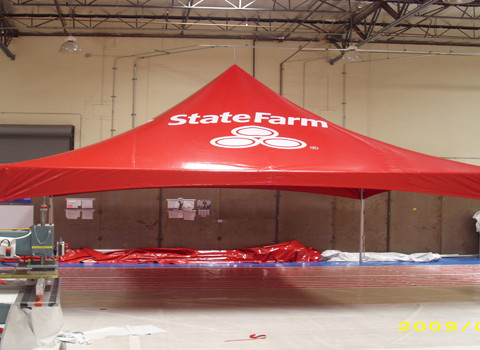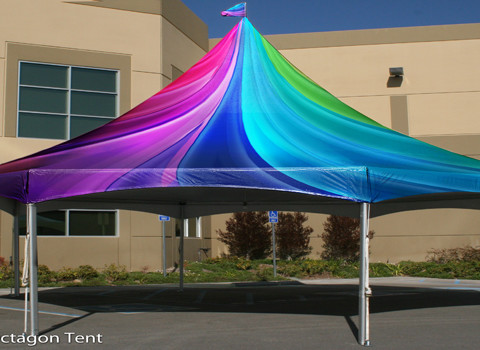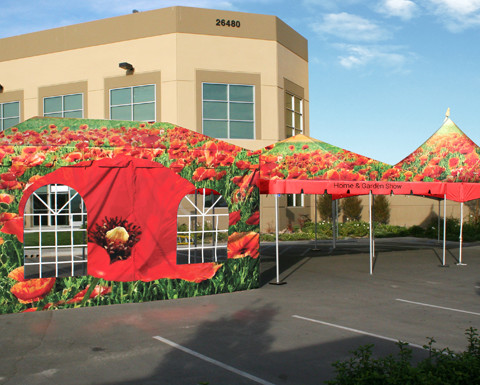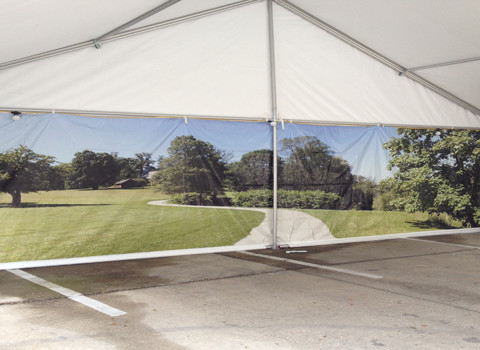Brides, corporate groups and art fair promoters look for venues that are aesthetically pleasing, offer access to auxiliary services and lie in proximity to the people they want to attend their event. When tent rental companies are involved, site evaluation elevates to a level that involves criteria their clients might overlook.
Matt Mutton, vice president of Bob Mutton Party Rental & Event Planning in Fort Wayne, Ind., notes that one of the biggest questions to be answered is whether the tent of the needed size will fit the chosen location. “That includes floor space, overhead wires, trees and things of that nature,” he says. “A conversation needs to be had on site with the customer. That’s where reality takes place. You can say, ‘I see you have a pool house out here. Where does the power come from?’”
Donny Vasquez, vice president of Made in the Shade of Sacramento, Calif., also considers it important to quiz property owners. If the tent is going to be weighted with water barrels, not only is water location important, but also water pressure.
“We try to educate our customers on what our needs are going to be,” he says. “‘We are going to be filling twenty-three 55-gallon water drums on your property. Is water pressure going to be a problem?’”
When Scott Sutherland, president of Olympic Tent in Tacoma, Wash., previews an event location, he looks for what is above, on, around and below the site. “Conducting a professional evaluation of a site consists of cataloging all of the physical measurements and looking for obvious trouble areas such as overhead wires, gas or utilities connections on surrounding buildings, signs of poor drainage, the slope and lay of the land, signs of prevailing wind direction and just basically being observant of the site and its immediate surroundings,” he says.
“Everybody thinks with rose-colored glasses: It’s going to be 78 degrees with no breeze,” Mutton says. “If it rains, where is the water going to run? A lot of times, you can’t understand the worst-case scenario until you are on the property.”
Sutherland likes walking a site with a customer so they can explore various possibilities early in the process. “It also is an opportunity to ask questions about the site,” he says. “Owners of property generally know if there are buried utilities, old foundations or issues with water ponding during heavy rains. Every time a tent goes up everything is in play. All codes have to be met, every time. The solutions are often site-specific, but the same questions always have to be addressed.”
That said, there are considerations that must be made for public events that don’t apply to private events, such as ADA guidelines for handicap access.
“The requirements of each site evaluation can change depending on the size and scope of the project, where they are in the decision and design process and whether or not the customer has hired an event planner, production company or full-service caterer,” Sutherland says. “In any case, I am the expert on my equipment and its usage—and I am responsible for its safe installation.”
Partners in time
“The more, the merrier,” Harold Sater says. And he’s not just talking about guests for a fundraiser or celebration of a couple’s 50th wedding anniversary. The owner of A&A Tent Productions in Shreveport, La., welcomes not only his customers and event planners at site evaluations, but also code inspectors early in the process.
“Every town and county and parish has different rules and regulations,” he says. “We have gotten jobs where we can’t be over a certain height because of apartments where you can’t block their view.”
In addition to the location of utilities, sprinklers and power lines, he says he needs to know whether his crew will be able to pull vehicles onto the site, whether there is a place to store equipment and how the tent can be anchored. Ninety-five percent of Mutton Party Rental’s site inspections are conducted between the tent company sales representative and customer. But, Mutton notes, “When you work with event planners, they like to have everybody involved.”
Having all the vendors participating early on helps avoid timing problems that can be overlooked. But that doesn’t always happen. So Made in the Shade calls the customer a day before delivery. “We let them know when we will arrive,” Vasquez says. “That alerts them that if they have A/V coming at the same time, we may need to move our schedule around.”
“Always have a checklist you work from, and go through it as you examine each job and talk with the customer,” Sater advises. “Make sure you know what they want and what they don’t want,” he advises. As for code officials, he says, “I try to bring them in as early as possible and keep them on my side.”
Mutton agrees with that strategy. “When we do a large event, we sometimes have contact with the fire marshal in an initial meeting, and we find that typically creates a much smoother sailing experience,” he says.
Made in the Shade has installed tents for multiple events at the California State Capitol. “When we do a site walk, we have to get the California Highway Patrol involved,” Vasquez says.
Three years ago, A&A put a tent on top of a riverboat casino. “We had the fire marshal, Coast Guard, casino staff and Losberger tent people there,” Sater says.
Returning to the scene
The number of site inspections performed by tent rental companies depends mostly on the size and complexity of the event.
For the riverboat casino job, A&A began planning six months out. “For fancy jobs, three to four months [prior to the event] is not uncommon,” Sater says, adding that even simple events may require more than one visit if the customer requests it. “We’ve had the grandmother and mother of a bride want to go over everything. When we dealt with General Motors, someone flew in from Detroit to go through everything we’d already done with a local GM person.”
“The majority of our clients only need one site inspection,” Mutton says. “We try to have them within 45 days of the event, but a lot of the time, all the details are not finalized. I can remember one event four or five years ago when, during the site inspection, we confirmed we could back our vehicle into the client’s back yard. Over the next two months, they had a lot of landscaping done and we could no longer fit along the side of the house. Everything had to be carried in and out.” Fortunately, Mutton had performed a second inspection a week prior to the event. “The biggest thing is having direct and clear conversations with the customer about loading and unloading,” he says.
Sutherland says he’s done initial site evaluations up to a year in advance of an event, but then multiple site visits are needed as changes, inevitably, occur—whether in the size of the event or in the landscaping.
Made in the Shade tries to keep site evaluations in a three- to nine-month window. But Vasquez visited the track at Sacramento State University five times in a four-month period prior to the U.S. Track and Field Championships. The track complex had been recently renovated, so Vasquez was not familiar with it and vendors were continually added.
Although their companies have site-evaluation forms, Mutton, Vasquez and Sutherland admit they don’t use them as often as one might expect. But they all make notes and sketches.
“I use several blank pieces of paper,” Sutherland says. “I have, in the past, used different forms. However, I have always returned to grabbing a blank pad, because there are no limitations with a clean sheet of paper. I always draw out a sketch of the site, and my notes can take up several pages. I need to have notes on the basics: who, what, where, when, why. And then it is my job to figure out the how.”




